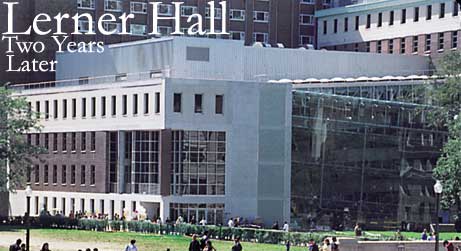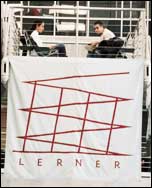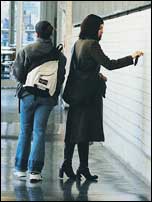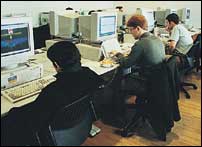 |
 |
 |
 |
|
COVER STORY
No one has ever claimed that evolution happens overnight. Though it is unlikely that Charles Darwin was referring to Ivy League student centers when he published his landmark tract on the developmental changes of flora and fauna in the mid-19th century, his basic principle that evolution happens over a period of time can easily be applied to Alfred Lerner Hall. Architecturally controversial when it opened in the fall of 1999, the campus's new student center is steadily becoming more appreciated and widely used. While there certainly have been growing pains, Lerner, through the combined efforts of administrators and student groups and the drawing power of events and restaurants, is clearly being transformed into a true center for Columbia students. "Though it took a year, Lerner Hall is being used beyond belief by student groups," Dean of Students Chris Colombo says. "It also has become a real community center for its causal user: students who use it to get food, check their mail and meet with friends." "Lerner has really grown on students," agrees student body president Ariel Neuman '01. "Almost everyone I know is using it more than before." Lerner Hall, of course, has the unenviable task of replacing a legend. For generations of undergraduates, Ferris Booth Hall was the Morningside Heights mecca for campus activities. However, by the early 1990s, the Board of Trustees began to realize that Ferris Booth, beloved as it was by alumni and students, was becoming outdated and downright dilapitated, and needed to be either extensively renovated or replaced. George Rupp's arrival as University President in 1993 ended that debate. "When President Rupp came to Columbia," Vice President of Facilities Management Mark Burstein says, "he made it clear that he wanted to improve the undergraduate experience here and that construction of a new student center would be part of making that happen. Ferris Booth was designed in the 1950s, and was built for a very different student population than Columbia has now: namely, for commuters. We needed a new building to support our new type of students." So Ferris Booth went down in a heap of bricks and memories in the summer of 1996, leaving Columbia without a student center for the first time in four decades. Bernard Tschumi, dean of the School of Architecture, was commissioned to design the new building; a primary donor, Alfred Lerner '55, was recruited to help fund it; and hordes of construction workers descended on campus to build it. And while some College students went through most of their undergraduate careers without a student center, Columbia's promise of a state-of-the-art structure that would be twice the size of Ferris Booth soon began to rise from the gaping hole in the ground adjacent to Carman Hall between 114th and 115th Streets on Broadway.
Though Spectator editorials on the building's apparent lack of progress would have had you believe otherwise, Lerner Hall opened on schedule in September 1999; a gala ribbon-cutting ceremony was held a month later, featuring an appearance by Art Garfunkel '62. The building was a marvel to behold: a traditional brick facade facing Broadway, combined with a sleek, ultra-modern glass wall overlooking campus, all joined together by an extensive series of ramps and steel. Architecture critics raved. Students complained. In forms of communication that varied from campus-wide e-mails to informal conversations, numerous students voiced their opinions that the new center was too sterile, too confusing, and most importantly, too empty. According to Harris Schwartz '59, a long-time administrator and former dean of residence halls who is now executive director, student services at Lerner Hall, the criticisms were not totally unexpected. "When Lerner first opened, the building's construction was still being finished off," notes Schwartz. "Students were beginning to see the building and not really understand how it all came together and could be used. "For a number of years, students existed in a nomadic, 'Ferris Booth-in exile' state, so when this building opened there was no tradition that carried over of using a student center. By definition, Lerner came with a learning curve." Part of students' apprehension towards the new building was that even when it opened, much of it was still closed. Though the ramps, the student mailboxes and the ground-floor dining option, Cafe (212), opened in the fall of 1999, a number of the building's marquis attractions, including the Ferris Booth Commons restaurant and the theater portion of the Roone Arledge Auditorium and Cinema, were still under construction. "We were committed to getting Lerner up and running as soon as possible," Schwartz says, "which led to some portions of the building still being under construction while the Hall itself opened. But once most of it opened, there was growing evidence that students were becoming more comfortable with it and making much more use of it." The numbers back him up. As of December 2000, Lerner was averaging 42,000 turnstile entries a day, up 65 percent from a year earlier. Its ramps are more crowded, its lounges are filling up, and general complaints about the building are dying down. What could bring about such a change of heart? "It's a building that's now really alive, and what made it come alive? Food!" says Colombo with a laugh. Lerner Hall contains two distinct restaurants, both on the campus side of the building. Cafe (212), located on the ground floor, specializes in sandwiches, salads and breakfast foods, while Ferris Booth Commons, located on the floor above (with additional seating another level up), is a European-style market that offers everything from pizza and pasta to sushi and stir-fry. According to Director of Dining Services Scott Wright, the two eateries - which each average over 2,200 customers a day - are the two busiest restaurants on campus, so popular that they have taken away a large portion of the business of other campus dining locations. "Cafe (212) has exceeded all expectations," Wright says, "and Ferris Booth Commons is doing almost as well. In fact, when we saw how popular (212) was last year, we changed the design of Ferris Booth in order to provide more seating for the overflow of customers."
Though he cites the administration's long-standing belief that feeding people in Lerner's restaurants would increase traffic in the building as a whole, Bob Moskovitz, Columbia's executive director of business services, still expresses surprise at just how well-received the two locations have become. "The menu that is offered in Cafe (212) and Ferris Booth Commons was created from a market research report done two years ago that revealed that students wanted fresh, healthy choices that were prepared in front of them," explains Moskovitz. "The menu at (212) is based upon that of the Au Bon Pain chain, one of the most popular among students according to our survey, while the one at Ferris Booth fills in the gap of those foods that were desired but not offered anywhere else on campus, like brick-oven pizza and especially sushi." The new dining options have been big hits with students. "I really like both restaurants in Lerner," says Michael Rubin '04. "They are more open and have better selection than any other place on campus." Though perhaps not as popular as Cafe (212) - so crowded that it is scheduled to undergo some renovations this summer to accommodate its constant heavy traffic - business also is booming for the Columbia bookstore in its new location, the basement of Lerner's Broadway side. "The bookstore's sales have increased to $9.8 million, an 11 percent jump over last year," Moskovitz says. "Having it in Lerner is great because it allows a student to go 'one-stop shopping' in the building." In addition to the Barnes and Noble-run bookstore, four other business locations exist in the new student center: Citibank adjacent to (212), STA Travel on the first floor, Copy Express on the third floor, and the Game and Pool Room at the top of the first set of ramps. Despite their popularity, however, there are no current plans to add any more retail to Lerner Hall. "Dozens of businesses want in," Moskovitz says, "but there's no need now to add anything. We don't want to take away space from students just to add some retail." Indeed, any attempt to take away space from students would probably be met with great resistance since, in the building's biggest controversy since the futuristic ramps were unveiled, Lerner is already dealing with a meeting space shortage. While 26.2 percent of the 225,000 square-foot student center is devoted to meeting and activity space, questions remain as to whether the allotted areas are adequate to meet the needs of the 2,389 student events that were held in Lerner during the fall 2000 semester alone. In addition, almost 700 non-student-affiliated events were held in the building that semester, adding to the crunch. Neuman, while acknowledging that Lerner on the whole is a great resource as a meeting space for student groups on campus, believes something must be done to make Lerner's meeting rooms more accessible to students. "Space issues are definitely Lerner's biggest problem," he says. "At the halfway point in a term, for instance, all the meeting space will be booked for the rest of the semester. And, since there's such an administrative push to get student groups to use Lerner, other meeting places on campus have become much harder to reserve."
Neuman's suggestions for changes that would make Lerner more group-friendly include keeping the building open 24 hours (currently, it closes at midnight during the week and 3 a.m. on Saturdays) and devoting much of the still-unfinished sixth floor to meeting space. Though asserting that "there is no budget, unfortunately, for keeping Lerner open 24 hours," Schwartz says he shares some of the students' concerns about meeting space and that some of the sixth floor may be used to alleviate those concerns, though no official plans have been approved. "Lerner's biggest weakness," he says, "is that there isn't enough Lerner to go around. We could double the space inside and it still wouldn't be enough for everyone." In an attempt to make sure that Lerner is booked "as fairly as possible," according to Associate Director of Student Services Dara Falco, a system of pre-calendaring has been instituted to ensure that if groups know their space needs early, they will get the areas in Lerner they request. "About 40 percent of all events are booked in the pre- calendaring period, which takes place the year before," Falco says. "The rest are done on a first-come, first-served basis, and all scheduling conflicts are mediated by the space and scheduling committee that consists of both administrative and student representatives." Despite the occasional difficulty in getting space, there is no question that Lerner is a valuable asset to student groups, according to Marc Dunkelman '01, lead coordinator of the Columbia Political Union, one of the many groups that calls the student center home. "It's really given the CPU a place to reach out to the Columbia community and the outside world of politics," he says. This concept of "Columbia community" lies at the heart of Lerner Hall's mission, according to Colombo. "In addition to all of its events," he notes, "one of Lerner's greatest strengths is that it facilitates informal interactions between students every day and builds a real sense of community here." However, the biggest component of this desired community, Columbia's student body, is still divided as to whether Lerner has actually fostered any of its much promised sense of school spirit. Andrew Pagano '01 doesn't feel that students were consulted enough in the building's design. "As a commuter," he says, "I'm a little disappointed and upset that there are no facilities for a commuters lounge here and that there are no real attempts at integration. There should have been some dialogue with students on issues." According to Jorge Herrera '01, president of the Columbia College Senior Class Committee, however, students - despite some legitimate complaints about the building - are by and large warming to it rapidly. "Lerner Hall has improved a lot in the two years it has been open," he says. "It's much more crowded and feels more like a location students want to be in. It has a great future ahead of it, and it's already showing it today." About the Author: Jonathan Lemire '01, having passed
his swim test, graduates this month with a double degree in history
and sarcastic Spectator sports columns.
|
|
|||||||||||||||||||||||||||||||||||||||||||||||||||||||||||||||||||||||||||||||||||||||||||||||||||||||
 Architecturally striking student center is growing in usage and
popularity
Architecturally striking student center is growing in usage and
popularity 

